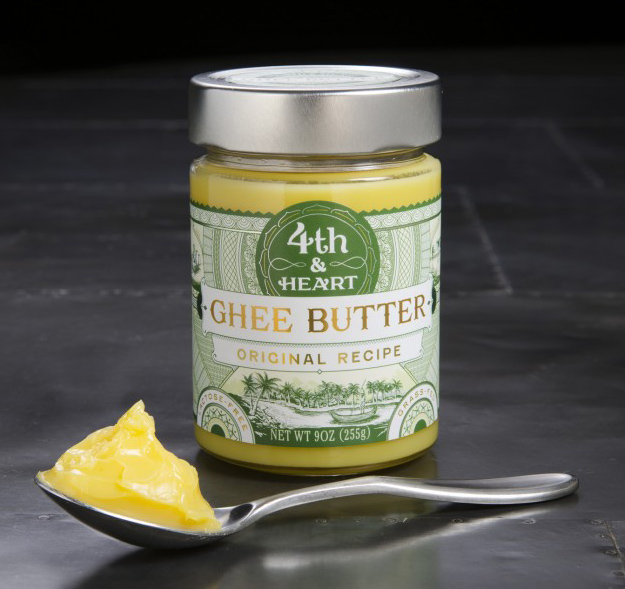Dairy is a staple of the Standard American Diet, but it has traditionally been considered not to be a part of a standard Paleo diet. The science really isn’t cut and dry though, especially when it comes to high-quality grass-fed dairy, so I consider dairy a grey-area food—it’s health benefits are considerable, but many people (myself included!) find it causes inflammation we’d rather do without (for all the pros and cons of dairy products, see “The Great Dairy Debate“). If you’ve discovered you can’t tolerate dairy, don’t despair! Make these easy swaps and you won’t even miss the real stuff.
Swap butter for ghee, lard or palm shortening
Butter is ubiquitous, especially in baking. But, it’s also delicious on a baked sweet potato, for sauteing or baking veggies, and even blending into coffee. And for good reason! This rich fat lends plenty of flavor whether used to cook or dress foods, and when sourced from grass-fed cows, it’s quite nutritious! However, for many people (myself included!) the amount of milk protein in butter is still enough to trigger a reaction (I personally get a migraine within about ten minutes!). Luckily, there are alternatives!
 If you’re looking for the same rich flavor as butter, ghee is a fabulous alternative. I like the grass-fed ghee from Fourth & Heart! It’s a traditional Indian cooking fat made by clarifying butter. That means the butter is gently heated until the milk proteins can be separated from the pure butter fat. Butter is only about 83% fat (the rest is protein and water) whereas as ghee is typically 99.7% fat, qualifying it as casein-free, whey-free and lactose-free. When it comes from grass-fed milk, ghee is rich in the same nutrients as grass-fed butter—namely the heart-healthy fat conjugated linoleic acid (CLA) and fat-soluble vitamins A, D and K2. Plus, it imbues your cooking with the same buttery flavor! One note of caution: though most ghee is almost entirely lactose and casein-free, it can still be problematic for some highly-sensitive individuals. For this reason ghee is eliminated on the Autoimmune Protocol, but is one of the first suggested reintroductions owing to its beneficial CLA and high fat-soluble vitamin content.
If you’re looking for the same rich flavor as butter, ghee is a fabulous alternative. I like the grass-fed ghee from Fourth & Heart! It’s a traditional Indian cooking fat made by clarifying butter. That means the butter is gently heated until the milk proteins can be separated from the pure butter fat. Butter is only about 83% fat (the rest is protein and water) whereas as ghee is typically 99.7% fat, qualifying it as casein-free, whey-free and lactose-free. When it comes from grass-fed milk, ghee is rich in the same nutrients as grass-fed butter—namely the heart-healthy fat conjugated linoleic acid (CLA) and fat-soluble vitamins A, D and K2. Plus, it imbues your cooking with the same buttery flavor! One note of caution: though most ghee is almost entirely lactose and casein-free, it can still be problematic for some highly-sensitive individuals. For this reason ghee is eliminated on the Autoimmune Protocol, but is one of the first suggested reintroductions owing to its beneficial CLA and high fat-soluble vitamin content.
For baking applications, lard and palm shortening are also excellent great butter alternatives. Both have relatively similar properties in terms of baking chemistry, and are fats that remain solid at room temperature. While even leaf lard (the purest form, generally used for baking) will have a slight pork-y flavor, palm shortening is decidedly flavor-free. For that reason, you might find lard more suitable for savory applications like pie crust, rolls or biscuits, and palm shortening a happier alternative for cookies or cakes.
Swap milk for nut or coconut milk
Paleo without milk means black coffee and very dry granola. But milk is actually one of the easiest dairy products to recreate! I like to alternate between nut milks and coconut milk, which have slightly different flavors but are both totally delicious!
 My simple recipe for Homemade Coconut Milk is my absolute favorite milk alternative. It’s creamy and delicious and has a very light coconut flavor. You can easily sweeten it too, making it a perfect alternative coffee creamer (try blending in a few pitted dates!). Plus, it’s incredibly cost-effective! If you prefer, you can choose a store-bought canned alternative. I always opt for versions that don’t include emulsifiers like guar gum, so my favorite brands are Natural Value or Arroy-D. Powdered coconut milk is also wonderfully convenient to have on hand.
My simple recipe for Homemade Coconut Milk is my absolute favorite milk alternative. It’s creamy and delicious and has a very light coconut flavor. You can easily sweeten it too, making it a perfect alternative coffee creamer (try blending in a few pitted dates!). Plus, it’s incredibly cost-effective! If you prefer, you can choose a store-bought canned alternative. I always opt for versions that don’t include emulsifiers like guar gum, so my favorite brands are Natural Value or Arroy-D. Powdered coconut milk is also wonderfully convenient to have on hand.
If you’re swapping for regular milk, I recommend using plain coconut milk or even diluting it slightly with water. For recipes that call for heavy cream or half and half, coconut cream or a mix of coconut cream and milk (you can skim off the top of a cold can of coconut milk or buy coconut cream here) work well.
If you can’t or won’t eat coconut, you can use the same process described in my recipe to make nut milk. I recommend making your own nut milk at home, since most store-bought brands include emulsifiers and other questionable ingredients. You can use any nut you like!
Swap yogurt for coconut yogurt
 Without dairy, you might think that recipes calling for sour cream, creme fraiche or yogurt are totally out. Conveniently, my coconut milk recipe is the base for a fantastic Coconut Milk Kefir “Yogurt.”
Without dairy, you might think that recipes calling for sour cream, creme fraiche or yogurt are totally out. Conveniently, my coconut milk recipe is the base for a fantastic Coconut Milk Kefir “Yogurt.”
If you aren’t comfortable fermenting yogurt at home, there are plenty of options available at farmer’s markets and grocery stores. I’ve had great success finding locally fermented coconut kefir (like a thin yogurt) at my farmer’s market and my local Whole Foods, and many local co-op stores might have similar finds. I like to use coconut kefir in place of sour cream in recipes.
For yogurts to replace my old low-fat favorites, my family likes So Delicious brands (somewhat thinner, and do include either rice starch or emulsifiers) or CoYo brands (thicker, more like greek yogurt, and absolutely no emulsifiers).
Swap cheese for nutritional yeast or cheese alternatives
So, I think we’ve established that butter can easily be replaced with ghee, and that coconut milk makes a great milk substitute. But what happens when you miss the cheesy flavor of…well…cheese?! A couple great alternatives are available in the form of nutritional yeast and plant-based cheeses!
Nutrivore Weekly Serving Matrix
An easy-to-use and flexible weekly checklist
to help you maximize nutrient-density.
The Weekly Serving Matrix is very helpful! I’ve been eating along these lines but this really helps me know where to focus vs. which foods serve a more secondary role. It’s super helpful and has taken a lot of worry out of my meal planning. Thanks!
Jan
 Nutritional yeast comes in flake form, and is perfect for sprinkling on top of veggies, potatoes or anything you might once have sprinkled with cheese. It adds a delicious umami flavor and, well, it just tastes cheesy. Just be careful to select a gluten-free nutritional yeast ( I like this brand), and if you have any sensitivity to yeast or fermented foods, be careful with this food.
Nutritional yeast comes in flake form, and is perfect for sprinkling on top of veggies, potatoes or anything you might once have sprinkled with cheese. It adds a delicious umami flavor and, well, it just tastes cheesy. Just be careful to select a gluten-free nutritional yeast ( I like this brand), and if you have any sensitivity to yeast or fermented foods, be careful with this food.
Another alternative (and one with a cheesier texture) comes in form of veggie cheeses, like zucchini or cashew cheese. These dairy alternatives rely on a mixture of veggies, nuts or nutritional yeast for flavor, and gelatin, oil and a few other ingredients for texture. I’ve tried a few variations of zucchini cheese and find it closely replicates the texture of American cheese. Try this recipe by Jamie over at Gutsy By Nature.
Swap ice cream for homemade alternatives
Now, let’s talk about the food you REALLY want to know how to survive without—ice cream! Trust me, I know how you feel. I absolutely love ice cream! But when I discovered that like many people, I don’t tolerate dairy (and that ice cream typically has a high concentration of milk protein relative to other dairy products), I became determined to make an alternative!
I’ve spent many years perfecting some fabulous ice cream recipes I think you’ll love. The advantage of making ice cream at home is similar among all the recipes mentioned above—you can control the ingredients! In particular, making ice cream at home allows me to monitor the type and level of sugar in my ice cream. I’ve even played around with naturally sweetening the creamy cold stuff with sweet potato!
 If you want to try your hand at coconut-milk-based ice creams at home, try my The Best Ever Paleo Vanilla Ice “Cream,” AIP Vanilla Ice Cream, Dark Chocolate Gelato (dairy-free, nut-free, coconut-free), Olive Oil Ice Cream, or Chocolate Frozen “Yogurt.” For something a little different, try Monkey’s Lunch Eskimo Pies!
If you want to try your hand at coconut-milk-based ice creams at home, try my The Best Ever Paleo Vanilla Ice “Cream,” AIP Vanilla Ice Cream, Dark Chocolate Gelato (dairy-free, nut-free, coconut-free), Olive Oil Ice Cream, or Chocolate Frozen “Yogurt.” For something a little different, try Monkey’s Lunch Eskimo Pies!
I often hear the suggestion that dairy is the one thing holding people back from committing to Paleo. Now that you know how many easy dairy swaps exist within the boundaries of Paleo, there’s absolutely no excuse! Give these dairy alternatives a try and you’ll be surprised how much you don’t miss!











